
By October, the sparkle of a new school year dims. Routines may run smoother, but emotions often run higher. Children who once skipped into school with excitement might now return home tearful, irritable, or withdrawn. This shift isn’t a sign of failure — it’s a sign of deeper adjust-ment. As novelty fades, kids begin to feel the full weight of academic expectations, social dynam-ics, and the effort it takes to regulate themselves all day long.
This shift is common. Once the novelty fades, children have fewer distractions from the chal-lenges of learning, social dynamics, and self-regulation. Big feelings begin to surface — not because children are failing, but because they’re adjusting on a deeper level.
Several factors fuel this emotional turbulence. Many children hold it together at school but re-lease pent-up feelings at home where it feels safe — the “mask slips.” Lessons shift from review to new material, increasing cognitive load. Friend-ships start to solidify, which can leave some kids feeling left out. And the long stretch from September to the holidays — with few breaks — wears down their stamina. Understanding these stressors helps adults respond with compassion rather than confusion.
Supporting emotional growth starts with help-ing children name what they feel. One helpful strategy is “Name It to Tame It.” When children label their emotions — for example, “You’re frus-trated because the math problem feels tricky” — it creates distance between them and the emo-tion, reducing its intensity. Also, offering second chances after outbursts — “Let’s try that again with calmer words” — teaches repair over punish-ment. Encouraging kids to retell tough moments as if they’re the author — “What could your char-acter do next?” — builds perspective and creativ-ity. And guiding them to notice where emotions live in their bodies — a tight chest, a clenched jaw — paired with grounding techniques like breath-ing or stretching, fosters self-awareness.
One parent shared how her son came home angry every day. Instead of jumping to solutions, she asked, “Where do you feel that anger in your body?” He pointed to a knot in his stomach. To-gether, they practiced slow breathing with a hand on his belly. Eventually, he began using the tech-nique on his own at school.
A playful tool like a “Feelings Menu” can make emotional check-ins feel less like therapy and more like a game. Kids choose from a list of emotions — happy, sad, nervous, excited — and pair them with coping “side dishes” like draw-ing, deep breaths, or alone time. Over time, you can expand the menu to include more nuanced feelings like proud, left out, or calm, and normal-ize the idea that it’s okay to feel more than one thing at once.
If your child tends to bottle things up at school and unravel at home, consider collaborating with their teacher on a small break strategy. Even a simple “reset pass” for two minutes of quiet time can help prevent emotional overload and give your child a sense of control.
Ultimately, big feelings are not a problem to fix — they’re part of growing up. When parents stay present through the messy, tearful, or explosive moments, children learn that emotions are man-ageable, not shameful. They begin to trust that no feeling is permanent and no feeling is too big to handle. This is the foundation of emotional resil-ience — the ability to face life’s ups and downs with confidence, clarity, and courage.
October is such a bitter sweet month. By now, summer is long over, autumn is waning, and winter’s clouds loom ahead. But there are golden days still left, too, with sunlight illuminating the brilliant reds, oranges, and yellows of the falling leaves. Some days the sky is so blue it hurts the eyes. It stretches across the horizon and beyond, interrupted only by mounds of marshmallow clouds. The air of October is so fresh, clean, and welcome even though it often turns nippy as the sun goes down.
Roadside stands are so lovely in October. Big piles of orange pumpkins balance next to several different varieties of squash. Dried corn husks and bunches of dried corn in various earthly colors beg to be bought and used as door decorations. The last of the flowers, deep red chrysanthemums and perky late season marigolds are almost loathe to let the season of life, and good things from the earth, slip by. A bunch of them make a fine bou-quet when placed in a simple glass vase and given center stage on the dining room table.
October is a good month to do a little bit of bak-ing. If sweets have been relegated to only special occasions at your house, you can always substitute a few loaves of healthy cinnamon-raisin bread. The oven will warm the house on a chilly fall day and send luscious aromas to every corner. If you time it so the bread is baking when the children return from school, they will get a tantalizing welcome when they open the back door. Home made bread is healthy for children, too, and they hardly know such good ingredients as wheat flour, honey, and whole milk have been added to the finished prod-uct.
Molasses cookies or ginger snaps, perfect addi-tions to the kids’ lunch boxes, also add to the deli-cious smells in your house this month. Treat your-self to some bright orange candles and add them to the dinner table in order to make a simple week-night dinner something special. Substitute bright orange paper napkins for the standard white ones, or, for variety, alternate red with orange and yel-low napkins. It will give the table the look of a few autumn-dressed trees.
Of course, October is capped by the spirited Halloween holiday. This ancient celebration nev-er ceases to be exciting, particularly for children. Most adults, no doubt, can reach into their own, private memory collections and pull-out several associated with this ghoulish holiday. Getting ready for trick-or-treating remains one of the most vivid of my own Halloween memories. It was al-most impossible to contain the suspense and anx-ious anticipation that liter ally squeezed a child’s heart.
We loved rigging up costumes for the annual house-to-house excursion in the dark. One year I was a cat with a tail so long it actually became a nuisance. The costume even had long whiskers. That year, I defied the belief that black cats brought bad luck and I had a swell time.
We began to get ready for trick or treating in the late afternoon. Shortly after 6 p.m., armed with flashlights, brown grocery bags clutched be-tween our fingers, we set off in small groups. Al-ways there was a parent on the fringes of the rag-tag delegation, smiling (and often freezing) as we traipsed through the night air in search of treats.
As a child, I lived near a cemetery. On Hallow-een night, we were careful to avoid houses right next to the black wrought iron gates of the grave-yard; it was just too scary to contemplate. But I’d steal a glance in that direction, often by the light of the October moon, and feel my heart freeze in fear. Human “cat” feet ran furiously to reach the street light closer to home.
We loved seeing what treats the neighbors chose to distribute to their goblin guests. Fat candy bars got raves; apples were definitely disdained. One year, a neighbor made trays of mouth-watering candy apples and unofficially won “Best Neigh-bor of the Season” award in the hearts of all the neighborhood children. I remember struggling to bite through the hard, sweet shell until my mouth came in contact with the tart, mushy meat of the apple beneath.
It was a wonderful, special treat that dark Hal-loween night and I’ve never forgotten it.
Once home, it was thrilling to empty our booty out in big circles on the living room rug. We loved our mother to come and survey the sweet bounty and we ferreted out her favorite candy bars and gallantly sacrificed them for her.
To this day I remember learning a Halloween song in about the second grade and I’d do any-thing to recall all the verses. Alas, they are lost, perhaps forever. But the song started out,
“Witches and goblins and jack-o-lanterns bright, Fly through the air on a cold October night”
This October, surrounded by pumpkins and squash, corn cobs, and nippy evenings, with good things coming from the oven, remember your childhoods while reveling in the present with your children, grandchildren, or friends’ children. But, at all costs, avoid dark graveyards after sundown on Halloween night unless you have cat feet, whis-kers, and a very long tail!


The Ballad of Congie,
the Beast of Congamond
By Phil Pothier
In Southwick, Massachusetts, are three lakes of some renown.
They straddle on the border over into Suffield town.
They’re deep, and cold, and somber, there are hidden dangers there.
The folks who brave these waters must do so with utmost care!
When summer’s sun is shining bright, and all is going well,
There is no care, there is no fear, there is no tale to tell.
But when the summer sun goes down, or storm clouds fill the sky,
Then fear and dread descend like lead on all who gather by.
For in these cold and watery depths there lurks a thing most foul.
On many a stormy summer night you’ll hear his mournful howl!
It is an ancient mystery, and Congie is his name.
A beast of myth, (so we suppose!) yet who can doubt his fame?
There’s many a boat which is no more, and things which disappear.
There’s many a swimmer’s awful tale of moments filled with fear.
Who knows if that great beast is real, but can we take the chance?
At this beast’s name there’s many a sigh, and many a fearful glance!
So, friend, consider these wise words, and guard yourself with care.
Be careful when you venture near, use caution when you’re there!
When storms assail or night descends be careful where you roam.
Escape the wrath of that great beast and stay safe in your home!
By Clifton (Jerry) Noble, Sr.
Oct. 1, Sunday. Baby (born 4-21-61) weighs 15 pounds 12 ounces. He woke me at 12:20 a.m. but went back to sleep af-ter taking a bottle of formula. I got up at 5 a.m. to shave and do chores. When the little reservoir behind the wellhouse was filled from the gasoline pump at brook the water rose 4 feet in well.
An electrician and Mr. Pero’s men in-stalled a new water heater. I painted spot on pink house where electric meter was removed, and swept the garage before going to play organ for communion service at church.
Elizabeth’s parents and Uncle David Atwater came. I loaned mother Atwater my book of short plays as she wants to produce “Red Carnations” for her Hopefully Well Affected Club. Being too busy to bring my mother, ”Hester,” to Mont-gomery, I phoned her at Sarah Gillette Home. She sounded a little sad
Oct. 2 to 6, Monday to Friday My survey party has been marking beam lines with concrete nails on Agawam bridge piers. Part of the time we had to work in rain. Bill Dwyer won $150 on the horses. John Manzi won $4.60 on the World Series pool. I don’t gamble.
Al Cloutier brought time sheets Thursday. He has been As-sistant Survey Supervisor, but will lose that temporary position and go on construction. Because of my permanent Civil Service grade V, I will replace him He plans to pick me up Monday to take me to Greenfield District Office.
Oct. 8, Sunday. Hester visited the Hollis Roots on New State Road while I played for church. The Atwaters had loaned us their Dodge, but we no longer need it as I will have a state car in addition to our two-door Ford. They and Uncle David came at 3 p.m. and took Hester and the Dodge back to Westfield.
Oct. 9, Monday. Al Cloutier had to ask in Russell where I lived so didn’t find me till 9 a.m.. He got me to Greenfield by 10. At 11:15 Supervisor George Berry took me to see District En-gineer Hugh Corr who sounded as if he wanted me to transfer to Right of Way (instead of upsetting temporary positions for his friends. However, I am good at survey and like it.) Despite feeling increasingly nervous and sick, I helped Al Murphy, the other assistant, move steel signs to the attic.
At 2 p.m. the phone rang and George passed it to me. I heard Elizabeth say, “Jerry, I’m at the hospital. Your little baby has a fractured skull.” She had left him unstrapped on his bath table. He rolled off and fell three feet to the floor.
I told George I would take sick leave and was at Noble Hos-pital in Westfield by 3:10. Mother Atwater was with Elizabeth. The lump made baby’s head 1 ½ times normal size. Ice packs had been applied every hour, and E had a rocker in which to hold him. Father William Hale had stopped by from Church of the Atonement. Dr. Wonson came back at 5 and noted that the head swelling was half as big as at 3. I went home from 5:30 to 6:30 and stopped at the State Police barracks to thank Herbert Spafford for taking E and baby to the hospital after the noon accdent. I called my mother at Sarah Gillette Home to let her know what happened.
Oct. 10, Tues, We were up at 4 a.m. E dressed and made beds while I got oranges and eggs for her. She took an extra bottle with baby’s toy lamb and left at 4:45. I miss him and miss giving him his morning bottle, but am glad she can be with him when he wakes up. I went in his room, knelt at a chair, got the tears out of my system and thanked God for giving him fast healing. On way to work I stopped at hospital and found Jerry much better.
At first I couldn’t find my survey men but, at the field of-fice, Dean Amidon had seen Louis. Adams, Hanley and Penna were out campaigning. With Bob and Louis I worked on bridge lines in Agawam. At Frank’s Service Station in Westfield I got lubrication for the old state Ford assigned to me. E took baby home but says he cries and needs lots of attention. Nurse Wat-son took his temperature at 98.6
Oct. 11, Wed. After collecting time sheets I have to initial them to approve the hours. Louis and Bob will take vacation Friday to have a long week end after the Thursday holiday. I phoned Supervisor George Berry to ask what to do with the men . He said vertical angle cross sections on Route 57 in Gran-ville need checking right away so I sent Louis and Bob there.
Oct. 12 Thur., Columbus Day. Most automatic laundries closed. I took my mother to ride over Norwich Hill and back through Loudville to Westfield. Baby looks well and happy.
Oct. 13, Fri. I arrived in Greenfeld by 8 a.m. but left at 9 to work in Agawam with the men who were not on vacation.
Oct. 14. Sat. I did laundry in Westfield and left checks at hospital and Dr. Wonson’s office. Jean W. found baby’s tempera-ture was 102 and called doctor. I got prescription at Templeton’s Back home E was praying. Baby was less snuffly and much cooler. He had caught cold in the hospital.
Oct 15, Sun. Church by 10:25 a,m. In. afternoon I amused baby with puppets. Rapisardas arrived. So E stayed in his room with baby because Cliffy had a cold and Irene smoked without asking. At 6:30 baby’s temperature was 98.
Oct 16, Monday. E says baby pulls off his booties and puts his toes in his mouth.
Oct 19, Thur. Warren Blanchard’s party arrived at 9:15 from Greenfield and had trouble finding the Agawam field office in the thick fog which also made work on ramps very difficult. I found an adjusting pin and checked a transit for collimation. Jimmy Constantino has tickets for speeding and traffic light violation
Oct. 20, Fri. At noon John Manzi took Jim to Springfield police station to turn in his license. (He got it back Saturday morning.) In p.m.I staked west end of Rte. 57 job with Bryda’s party. Between requests for staking from contractors and the Agawam Town Engineer my parties are busy’
Oct. 22, Sun. I had to get a new battery, $21.75, for our car before going to church.
Oct. 23 Mon. At Blydas in Northampton I had to wait un-til 4:30 to get door handle repaired on state Ford. Meanwhile I drove a customer to Easthampton for them in a company car. Keeping more than two feet of water in bottom of my ten foot well means running the brook pump almost daily.
Oct. 25. Wed. I started work at Southwick’s Gorge Road at 7:45. I get along fine with the men because they all have worked with me before . Dick Barker arrived first. He has given up his dance studio in Ware but still has about 50 students in Indian Orchard. Al Kacavich took his car to Granville for another load of flat rook from the blasted cliffs to bring home to Fiskdale. At Sears I bought new diamond needle. $4.95, for my phonograph .
Oct 26, Thur. In addition to reassigning parties and collect-ing time sheets. I did more routine survey work with the men. Hester had a nice visit at Bessie Sibley’s egg farm in Tatham. Bes-sie has free water from her late father’s permitting the Spring-field water main from Cobble Mountain to cross their land, Hav-ing no sewer she uses an outhouse. She housed my mother and I for four days when we had to leave our riverside cottage during the 1949 flood
Oct 27, Fri. I was in Greenfield office by 7:46 but left by mid-morning when George and Boston’s Phil Grout went for coffee. Phil says the Department has so much highway and bridge con-struction work that they need to appoint 117 permanent junior civil engineers. I took the back road through Whately to avoid one-way traffic at Route 5 and 91 construction At 2:15 I phoned Elizabeth from the booth on the corner of Westfield Street and Rogers Avenue in Tatham. Her trip with nurse Jean to Dr. Won-son was most successful Baby was fine and weighs 16 pounds 8 ounces.
Oct. 28. Sat. After laundry and taking my mother to ride, I hiked through beautiful foliage over Rockhouse Mountain which overlooks Huntington’s suspension footbridge to “Little Canada.” On the mountain I found a cave under huge boulders.
Oct. 29, Sun. We got up at 5 by Daylight Saving time. It has been so dry that I started brook pump while E made formula. After chores I tried to turn on radio at 7:20. Staion WTIC, which starts at 7, wasn’t on because today we have changed back to East-ern Standard so the time was really 6:20. I took junk to dump and got the Sunday paper and gas in Russell. Hester helped me with choir at church, and Bruce Morgan preached a good sermon. Elizabeth had a fine dinner for us all. After filling the wellhouse reservoir I drained the pump to prevent freezing overnight. Fro-na Camp called to say Edgar “Hiker” Moore died. We promised $2 toward flowers. I took Hester home via Cobble Mountain. The lake water was low but I have seen it lower
Oct. 30, Mon. Cloutier has been allowed to keep the state Mercury he had been driving, The old black Ford, with rust holes assigned to me by the DE made it to Greenfield by 7:45. (ALL the office personnel I knew then have passed away, but there are still folks who will remember them.) Party chief Ed Blake lives in Greenfield. He came in the office before going south to Laurel Street in Longmeadow. He told me he discovered the foot mis-take he thought I had made was actually in the final baseline put down the last time part of the street was reconstructed.
I stopped to leave $90 monthly check at SGH and see Hester. She met a pleasant Puerto Rican neighbor and tried out a little of the Spanish she has been studying.
Oct. 31, Tues. Jim Constantino had to go to court today about his traffic violations. I phoned E at 12:45, and then got needed diapers and nipples at Zayers. I stopped at Frog Hole on the Westfield River to look over Louis’ work and walked 3/5 miles up the river to trace an extra channel. Relocating a Route 20 curve involves a lot of survey.
Dottie Barnes brought Brian and Larry to show E their cos-tumes. She is chairperson of the Russell Community Halloween Party. Just as I left for the Glen Launderette Mrs. B Sr. phoned. She talked about Edgar Moore being cremated and tried to pump E about my job. The Halloween mess has started in Russell.
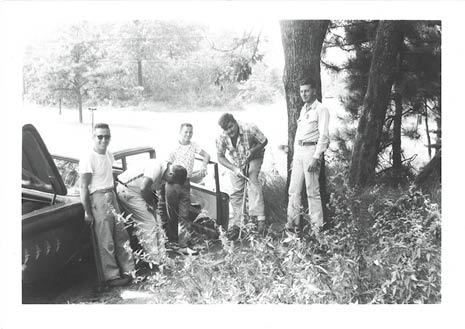
From left, Vincenzo Penna, Dick Barker,
Bill (Butch) Dwyer, C.J. (Jerry) Noble
October 1961

This aerial view of the Greenfield railroad station complex taken in 1950, before the fire. Photo by Peter S. Miller.

October 2014
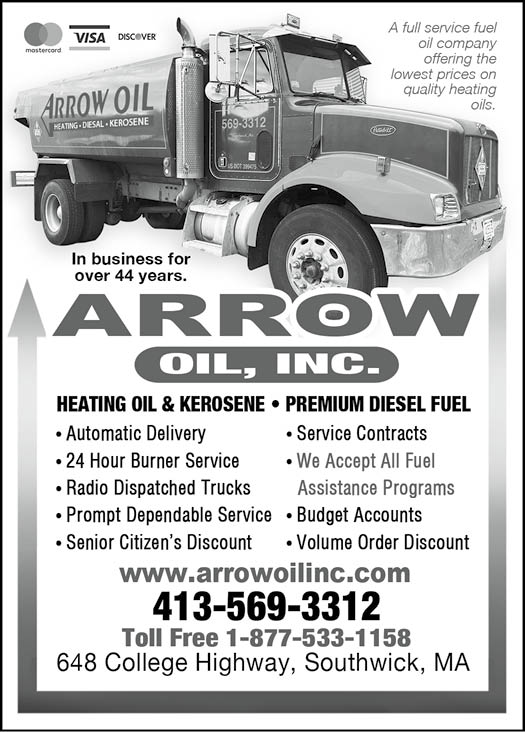

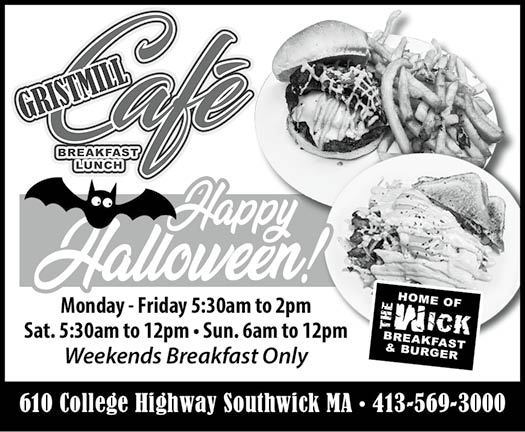

















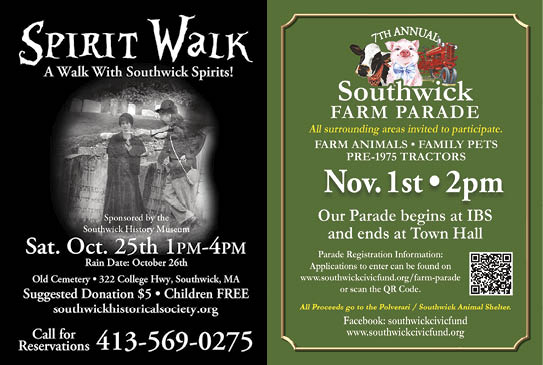


By Susan Guerrero
Inside the Young Mind:
Navigating Emotional Ups and Downs
By Dr Simone Phillips, Psychologist

A Psychologist’s Guide

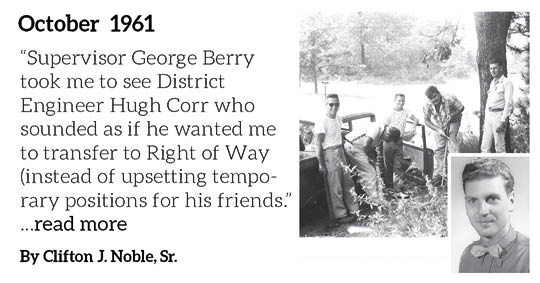
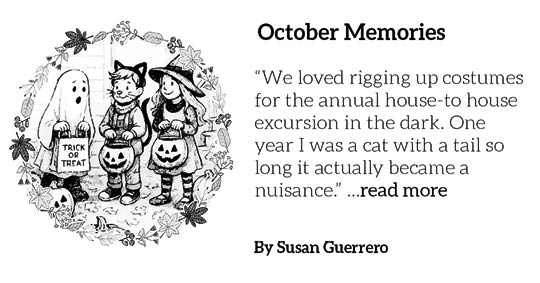
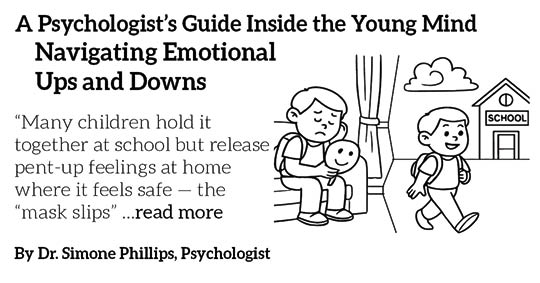
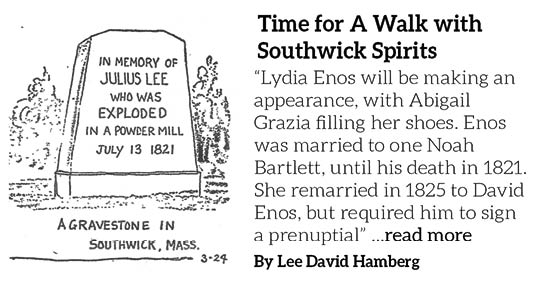
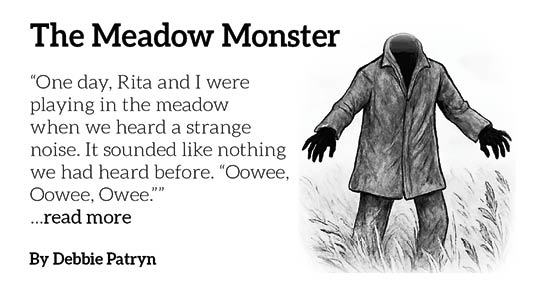

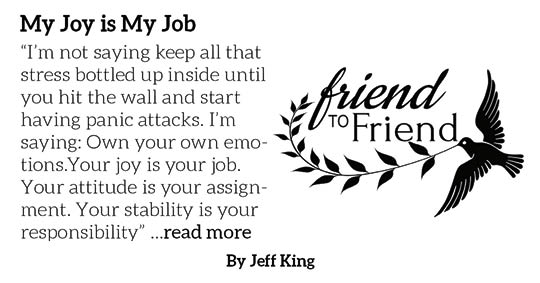
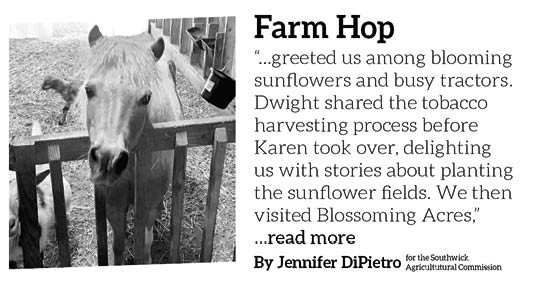









For the thirteenth year in a row, the South-wick Historical Society, Inc. is presenting “A Walk With Southwick Spirits” at the Old Cem-etery in Southwick on October 25th.
Few events are more anticipated than this Cemetery walk. For many folks, both attend-ees as well as re-enactors, it’s a favorite event of the year; A variety of Southwick citizens are portrayed each October by different locals. Over the years I have been able to portray Roger Moore, Matthew Laflin III, Richard Dickinson, John Mason, and Rev. Abel Forward. The intent is always to “bring to life” some of Southwick’s former citizens. While many individuals were outstanding, others are remembered solely be-cause of their crimes! While there are some “fa-vorite” characters, each year one or more new ones dances across the stage.
This year, we have some favorites, along with some new presentations or characters. Histo-rian Maud Gillett Davis will be represented by former Southwick educator Deb Patryn. An extraordinary amount of local history was pre-served because of Maud’s commitment to put-ting it down on paper. Her 430 page “Historical Facts and Stories About Southwick” is still a go-to source for understanding the community’s heritage. An index to that work prepared by the Southwick Historical Society, Inc. makes it easier to use.
Eric Muldrew of Agawam portrays South-wick’s Julius Lee. Lee was just 21 years of age when he entered that king-dom, “not made with hands, eternal in the heavens.” He was working in a pow-der mill alone, prob-ably on the Westfield-Southwick line, when an explosion occurred. He sur-vived just one hour. An artist’s rendition of his headstone was included in Ripley’s “Believe It or Not” column of March 24, 1932. It reads, “In Memory of Julius Lee who was exploded in a powder mill July 13, 1821”
Lydia Enos will be making an appearance, with Abigail Grazia filling her shoes. Enos was married to one Noah Bartlett, until his death in 1821. She remarried in 1825 to David Enos, but required him to sign a prenuptial agreement, a rare thing in that day!
Roger Moore, a private during the American Revolution, will share the stories of his service in the Danbury, Connecticut and lower-eastern New York theaters of war. While we think of Lexington and Concord, or the Forts at Ticon-deroga and Saratoga as· battle sites, the Brit-ish also made incursions into southwestern Connecticut and across the New York line as a means of diminishing American supplies for the war-effort.
One of the saddest lives of any Southwick resident was that of Keturah Holcomb. She will be brought back to life by Alex West. Keturah was married to Henry Holcomb, a son of Rev. Amasa Holcomb. In a fit of rage, Henry beat her half to death with a club in the cellar of their home. Her injuries were so severe that she only partially recovered and sadly spent her remain-ing years in the Northampton Insane Hospital. When her husband died 13 years after her, he was buried next to his wife, as though nothing had happened!
Representing Lydia (Wheeler) Hunt this year will be Denise Muldrew, historical society pres-ident. Lydia lived in Southwick until her death in 1904. While it may seem hard to believe, her father, Stephen Wheeler, was a soldier in the American Revolution (1775-1783). This made Lydia a real Daughter-of the American Revolu-tion!
Award winning actress Elaine Kuzmeskus will once again portray the infamous South-wick ax murderess Martha Vining Ottenheimer, sometimes· referred to as “the Lizzie Borden of Southwick.” As she clenches the actual murder weapon, she calmly recalls the reason for blud-geoning her elderly father, Lester Vining, to death in 1938, while standing next to his grave! The crazed glint in her eyes, the ax, and a believ-able presentation; make her an annual favorite.
Select Board member Doug Moglin will por-tray Amasa Holcomb, Southwick’s Renaissance man of the 19th century. A predominantly self-taught man, Amasa (pronounced· A’-ma h-sa h) taught at Suffield Academy when he was 15 years old, published two almanacs by age 20, surveyed land, was a Methodist preacher, and most importantly the country’s first telescope manufacturer!
Regional historian Dennis Picard of Westfield will be representing Capt. David Ives, a Revo-lutionary soldier who was one of the “Green Mountain Boys,” prior to relocating to South-wick. This portrayal will round out the offerings at this year’s “A Walk With Southwick Spirits.”
“A walk with Southwick Spirits this year will be Saturday, October 25, 2025 from 1:00 to 4:00pm with a rain date of Sunday October 26. Location is 322 college hwy., Southwick. Enter through the main gate of the new cemetery and proceed to the left rear corner for parking. Reser-vations are strongly suggested to avoid delays and assure a spot. You may call (413) 210-5870 to reserve. Suggested donation is $5.00. Wear com-fortable shoes as the ground is uneven and not level and have a jacket, etc as weather dictates.
By Todd Shiveley
Ten years ago, the Agawam Paranormal Society (A.P.S.) arrived in Southwick to conduct a full investigation into reported para-normal activity at both the Town Hall and the old library. This took place during the winter of 2014 into early 2015. On October 16th, they held a public lecture in the auditorium to present their findings—drawing an overflowing crowd, with not a single seat left empty.
Rob Goff, the leader of A.P.S., served as the event’s keynote speaker. Two Southwick Town Hall employees, Cindy Pendleton (then on the Board of Selectmen) and Pat McMahon (of the Cultural Council), also participated in the in-vestigation and shared their experiences as witnesses. The team discussed the equipment used, including EMF (electromagnetic field) detectors, voice recorders, and lightly wound mag flashlights designed to flicker on and off in response to spirit interaction. Several videos and photographs of ghostly orbs were shown, along with audio recordings of voices captured in both buildings.
In the basement of the Senior Center, particu-larly on the billiards table, multiple devices reg-istered voices and light signals indicating “yes” and “no” responses. Cindy repeatedly con-firmed the presence of activity. At one point, in the children’s section of the basement, she and a fellow A.P.S. investigator witnessed a stuffed animal move on its own. The team corroborated this sighting, claiming the presence of a young boy and girl among other spirits haunting the Town Hall. They also identified a playful 30-year-old male spirit on the fourth floor who enjoyed jokes and banter.
Another male spirit detected in the Senior Center was less friendly—though not malicious. The team’s psychic believed he had served in the military and preferred the company of male senior veterans. The specific war or conflict he may have been part of remains a mystery, one we may explore further.
The investigation at the old library revealed pronounced activity, with voices clearly heard and compelling evidence presented to the audi-ence, myself included.
Fast forward seven years to 2022, when the Western Mass News team featured a segment on the Southwick Library’s new ghost-hunting kits, now available for checkout. Any Southwick resident over the age of 18 with a library card can borrow a kit containing a digital thermom-eter, an EMF detector, a voice recorder, three walkie-talkies, and the book Ghost Hunting for Dummies. In the interview, reporter spoke with Michael McMahon, Chairman of the Library Board of Trustees, who shared that interest in ghost hunting surged following the A.P.S. lec-ture. “Ghost hunting is very popular in South-wick,” he noted, referencing the earlier investi-gations. “The old ghost stories passed through the town got residents curious to learn more.” He also mentioned that the Town Hall was for-merly the Consolidated School, built in 1929 and serving for decades as the local elementary school.
What McMahon didn’t mention and what Rob Goff himself may not have realized, is that before the Consolidated School was built, the site was home to a Revolutionary War-era tav-ern. During intermission at the A.P.S. lecture, while being photographed by the Westfield News, I spoke with Rob Goff about the Doane Tavern that once stood there. Its history could explain some of the lingering energy. Taverns, after all, were often sites of rowdy behavior, gambling, and other vices. They also hosted travelers and families—including the Doanes: Enock, Mabel, and their seven daughters. Maud E. Gillett Davis, in her Historical Facts About Southwick, recounts one daughter’s memory: “My remembrance of the parlor as a girl was a big wax doll to ‘look upon and not touch.’ In the rambling attic, we played on rainy days.”
As those familiar with my work know, I’ve had my own share of ghostly encounters and research. With the Town Hall built atop the for-mer school—and before that, the tavern—it’s no surprise that residual energy and voices, espe-cially those of children, continue to manifest. These layers of history may not only coincide with the evidence gathered but help explain it.
And let us not forget, if you are looking for a safer way to interact with “spirits”, the South-wick Historical Society, Inc’s annual Spirit Walk in the old cemetery returns for its 13th year on October 25th from 1 to 4pm. Wishing you a wonderfully spooky and haunted Halloween!

I grew up in the 1950s and early 1960s in Wrentham, Massachusetts. It is a town that is more than 350 years old. We lived on West Street, and like most of the town, our prop-erty and my grand-parents’ next door were surrounded by old stone walls. I am sure that when the land was first settled in the 1600’s stone walls were used to denote property lines. Those walls are still there 350 years later, al-though the pastures are long overgrown.
Our house was over 100 years old and situ-ated near the road. My best friend, Rita, lived just up the road from me. We used to walk along the top of the stone walls that connected the two houses. We spent nearly every day to-gether making fairy houses in the woods, bom-barding our brothers with acorns from high up in the trees, and playing hide and seek in the overgrown meadow at the back of the property. At times, the meadow grass was very tall. We could run through it, fall, and be totally invis-ible.
One day, Rita and I were playing in the mead-ow when we heard a strange noise. It sounded like nothing we had heard before. “Oowee, Oowee, Owee.”
We didn’t know what it was, but we started imitating it.
First the noise, “Oowee, Oowee, Owee. We repeated, “Oowee, Oowee, Oowee.”
“OOWEE, OOWEE. OOWEE,” came the noise louder this time and closer. “OOWEE, OOWEE, OOWEE,” we repeated.
“OOWEE, OOWEE, OOWEE,” the sound was loud and very close.
All of a sudden, we saw this huge, head-less creature rise out of the meadow, running straight for us. We screamed and ran for the house. The creature was following us, making that loud, scary noise. We were almost back to the house when we looked behind us and saw my cousin Tommy rolling around in the grass at the edge of the meadow. He was the Meadow Monster. He was next door visiting our grand-parents when he heard us playing in the mead-ow. He pulled his black jacket over his head, hid in the grass, and started making that terrifying noise. When Rita and I got close, he jumped up and started chasing us. He looked just like a headless monster chasing us.
We never did forgive him for that prank, and we were always more wary when playing in that meadow.
The Meadow Monster
By Debbie Patryn





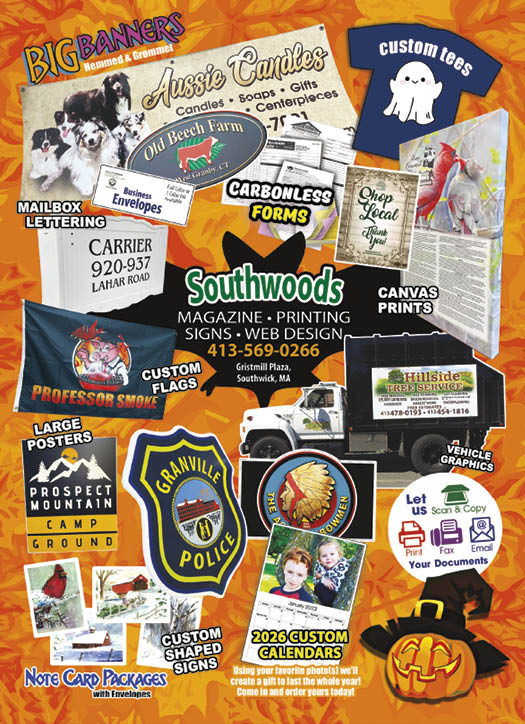







My Joy is
My Job
A dad asked his kids, “Who’s the happiest person you know?” He was hoping they’d say, “You are, Dad! You’re awesome! We want to be just like you!” But they all said, “Mom. Definite-ly Mom.” He was hoping he would at least get an honorable mention!
How about you? Would the people you live with and work with you every day say that you’re a super happy person? Would you at least get an honorable mention?
Brian Wilson from the Beach Boys once said, “I’m 70 years old and it took me a long time to learn a really simple thing: It’s hard work to be happy.”
I get that. It’s hard work to manage your own feelings. It’s hard to control your own emotions. So, I want you to lean into this little phrase …
My Joy is My Job.
Your feelings matter – but they can be fick-le. You are an emotional person – but you are not your emotions. I’m not saying to bury your feelings. I’m not saying just move on after that breakup broke your heart and pretend you’re fine if you’re not. And I’m not saying keep all that stress bottled up inside until you hit the wall and start having panic attacks. I’m saying: Own your own emotions. Your joy is your job. Your attitude is your assignment. Your stability is your responsibility.
It’s nobody else’s job to make you happy. Your spouse doesn’t have that obligation. Or your kids. Or your boss.
They can be there for you, but they can’t shoulder the weight of your happiness. They would suffocate under that expectation, because your joy isn’t within their jurisdiction. Only you can answer for your attitude.
A grateful heart is a stable heart.
There’s an old story called the Parable of the Chinese Farmer. It goes something like this … There was a farmer who lived in a small village in China. One day, his horse ran away. The vil-lagers came by and said, “What bad luck!” The farmer said, “Maybe.”
A few months later, the farmer’s horse re-turned, and it brought a herd of wild horses with it. The villagers came to congratulate the farmer. “What good luck!” The farmer said, “Maybe.”
Soon after, the farmer’s son was trying to tame one of the wild horses, but he fell off and broke his leg. The villagers came to offer their sympathies. “What bad luck!” The farmer said, “Maybe.”
Then a war broke out in the region, and the emperor’s soldiers came to the village to take away all the young men to fight. However, the farm-er’s son was exempt because of his bro-ken leg. The villagers came by again. “What good luck!” Again, the farmer said, “Maybe.”
That’s how the sto-ry ends. It could go on forever – and that’s the point. The lesson is: You can’t really tell if some-thing is good or bad, at least not in the moment. All you can say is, “Maybe.”
Now, that poor Chinese farmer could only trust in luck. Bad things might turn out to be good things, and good things might turn out to be bad things. Life has a way of fooling you, of yanking your emotions back and forth. Here’s the thing, though. You don’t have to trust in luck. You trust in a God who is present in your life and has good plans for your future.
God has already said to you: “For I know the plans I have for you, plans to prosper you and not to harm you, plans to give you a future and a hope.” (Jeremiah 29:11) Personalize that! Put your name in there: “___________, for I know the plans I have for you!”
I’ll show you two strategies that can make the most difference and the quickest difference, and I want this to be practical, not theoretical.
The First Strategy is: Fill up your mind with grateful thoughts.
Be like the woman who posted on social me-dia … She was having a horrible day, and in the video she appeared to be hiding in a closet. She said, “I need help right now! Somebody tell me the best technique you’ve got to keep from losing your mind when you’ve been with your kids all day. Something that won’t send me to jail and will work right now. And I don’t want to hear, The days are long but the years are short. I need some real-life stuff.”
She used a stronger word than “stuff,” but you get the point. Sometimes you don’t need a slogan or a 7-step strategy. Sometimes you need some real-life “stuff.”
Well, here’s some real-life “stuff” … You can’t stop the bad thoughts from coming, so don’t try. Instead, stabilize. And how to you stabilize? Gratitude.
One exercise you can use is to say (out loud if possible) 8 things that you’re grateful for right now. Now, here’s the exercise. Trace the fingers on each hand as you count down. If you start on the outside of your pinky and go back down on the inside, by the time you get to the thumb, you’ll be at 8. Now you’ve got a hand full of blessings. It’s a tactile reminder that everything good that I have comes from God’s hand.
Why 8? I like the word play … GR8FUL. Get it? Fill your mind with GR8FUL thoughts. Pick 8 things, as fast as they come into your mind.
I’m grateful that I have Kathy at my side. I’m grateful that I have a job that I love. I’m grateful I go home every night to a beautiful home. I’m grateful for getting to spend this time with you. I’m grateful … I’m grateful …
It’s that easy. The point is to get your mind out of the negative flow and into a positive one.
The Second Strategy is: Focus on the big pic-ture, not the small annoyances.
Too often we lose sight of all the big blessings in our life because we’re focused on one little thing that annoys us at that particular moment. A person who pushes your buttons. A situation that’s not going your way. A job that should have taken one hour takes three. So, step back and focus on the big blessings.
Start with this question: If I lost what I love the most, what would I give to have it back? If I lost my wife, what would I give to have her back? The answer came instantly, automatical-ly. Everything. I’d give everything to have her back. I would spend every dollar, I would sac-rifice every dream, I would go through any in-convenience. I’d give everything. Then what do I have right now? Everything. I already have ev-erything. If she’s worth everything to me, and I have her, then I have everything. Once I started thinking this way, the list kept growing. If I lost my kids, what would I give to get them back? Everything.
Now, maybe you have lost something you can’t get back. I don’t mean to bring you pain by putting it this way. But even in the greatest loss, I’m sure someone or something comes into your mind that you currently have. What does that relationship or blessing mean to you? Is that a reason to be grateful?
Beyond human relationships, you have a God who loves you and holds you close to His heart. You have forgiveness of your sin and a home in Heaven. If you lost that, you would give every-thing to have it back. You have God right now. You have forgiveness right now. So, you have everything.
You have breath in your lungs right now. If you lost your ability to breathe, what would you give to have it back? Everything.
That doesn’t mean there aren’t still unfulfilled desires. That doesn’t mean there aren’t painful problems. That does mean you have a perspec-tive that enables you to stabilize you when the world seems to be crumbing around you.
Because remember: Your joy is your job. And you want to do a good job with your joy. So, do it right now. Think of your GR8FUL 8. Trace your fingers if it helps. Ready? 1 … 2 … 3 … 4 … 5 … 6 …. 7 … 8. Go!

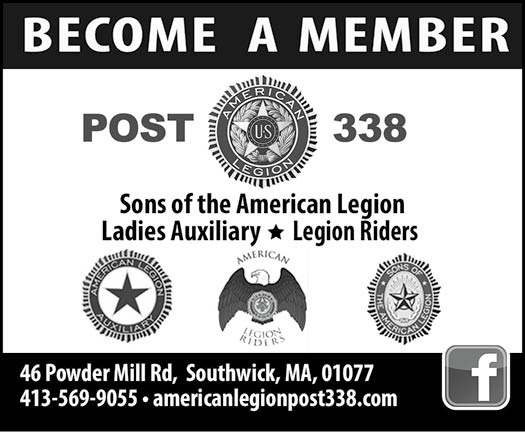







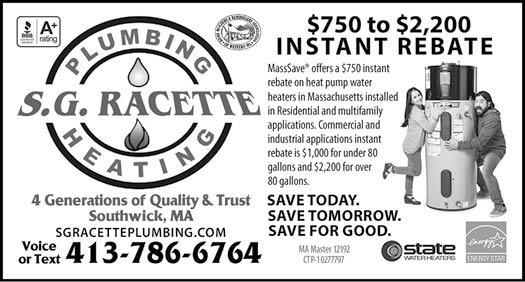



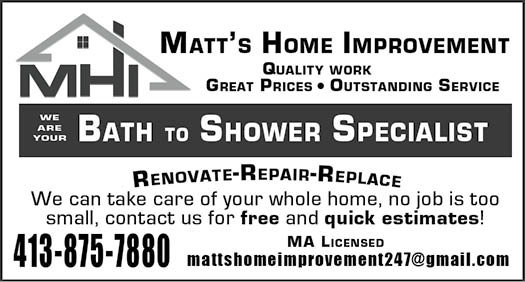
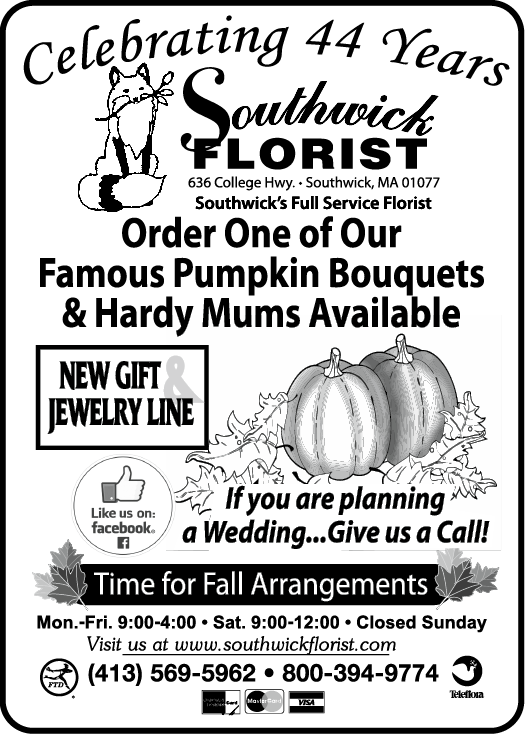


Right - Home of Lester Vining of Vining Hill Road who was killed with an axe by his Daughter Mrs. Martha (Vining)Ottenheimer.
Left - Picture of Warehouse workers outside Calvin Miller Warehouse in shed back of home on west side of college highway. Girl in front is Martha Vining

A Walk with
Southwick Spirits
A Walk with
Southwick Spirits
By Lee David Hamberg
March 24, 1932 Column of Ripley’s “Believe it or Not.”


Time for


During the warm month of June, flower-loving wife Susanna sprang into action. In her green-thumbed hand were several seeds ready to ger-minate. Love and attention are Susanna’s gifts. At harvest, we see the colorful, joyful outcomes dili-gently watched over by a tall gentle giant gleam-ing like the sun.
Sunflowers are steeped in symbolism and meaning. For many, they represent optimism, positivity, longevity, and happiness. Their vibrant appearance and connection to the sun make them a powerful model for keeping your eyes on the prize. They serve as reminders of love and devo-tion, reflected in their ability to turn toward the sun—symbolizing an eternal longing for light and warmth.
Exploring the biblical significance of sunflow-ers reveals deeper insights into their spiritual role of following God’s light faithfully for nourishment and growth. Using an instinctive action known as ‘solar tracking,’ the sunflower head moves in syn-chronicity with the sun’s path across the sky each day—from east to west—returning each evening to begin again the next day. They also require a lot of sunshine. A sunflower needs at least six to eight hours of direct sunlight daily to reach its full potential. They grow tall, stretching above other plant life to gain even more access to sunlight.
Sunflowers also provide nutrition being used for oils and a substitute for peanut butter, known as “Sunbutter.” This creamy, nutritious delight contains more vita-mins and minerals than most nut butters. Its ingredients deliver a triple punch of pro-tein, fiber, and healthy fats packed into every sunflower seed sup-porting good health while Sunflower oil is a great source of vitamins A, D, E and B-group as well as iron and calcium. They also con-tain phosphorus, selenium, magnesium, and cop-per needed for healthy living. Even when there’s no sunlight, sunflower oil can provide your daily dose of vitamin D.
These jewels among flowers naturally help de-contaminate soil. They can absorb hazardous ma-terials like uranium, lead, and arsenic. So next time our nation experiences a natural disaster, sunflow-ers might be part of the solution.
Sunflowers are not just garden staples; some na-tions have chosen them as symbols. Ukraine uses the sunflower as its national flower, while Kansas has adopted it as the state flower.
I embolden to become like a sunflower beaming with joy and Nonotuck Park’s swimming pool in Easthampton becomes my garden. Susanna and I jump at the opportunity to engage mind and body, participate in the cool-water two days a week in summer. One and a half hours of social engage-ment paired with the best exercise. Aqua aerobics provides tremendous benefits for individuals with Parkinson’s disease. Susanna is a model of deter-mination, whether on land or in water.
Like sunflowers standing tall and bright even in challenging environments, so too are the home-town heroes. I learned of a man traveling with his father came upon a stalled vehicle that had just burst into flames. Without hesitation, father and son jumped into action, saving the stunned oc-cupant out of imminent danger. Another story of bravery took place at Alaska’s recent state fair. A violent fight erupted when a towering man no-ticed someone holding a gun, ready to fire. Like the sunflower—tall, strong, and drawn to light—he immediately tackled the gunman and disarmed the potential assailant. Much like the sunflower soaking up hazardous material, this man absorbed the danger. The message is crystal clear: in times of urgent need, you are more than capable. Keep your eyes lifted and respond with strength, cour-age, and love for others.
Just as sunflowers instinctively turn toward the light, we too must stay alert when opportu-nity knocks. Action-oriented individuals radiate strength and warmth, drawing the attention and admiration of others. Like sunflowers standing tall in any field, be that bright presence in someone’s life.
During the 2024 Farm Forum hosted by the Southwick Agricultural Commission, a farmer proposed an idea that blossomed into a new event designed to connect seniors, who might not be able to join the annual Open Farm Day, with local farms throughout the summer and enjoy a meal together.
As a member of the Agricultural Commission since August 2023, it was a joy to help bring this idea to life. Planning began with Cara Cartello from the Council on Aging, whose event expertise and care for seniors were invaluable. I have a per-sonal connection to the Southwick Senior Center. I first visited in 2012 with my mom, Lise, a long-time Southwick resident, we shared lunches with her brother John and took weekly Zumba classes. These cherished memories are especially mean-ingful now, as my mom has been diagnosed with dementia and can no longer enjoy the center’s ac-tivities. The Council on Aging has been a guiding light for me, and leading the Farm Hop felt like a small way to give back.
Our first Farm Hop took place on a rainy June 17th. We visited Firefly Fields, where Lindsay created a cozy space for our group to meet her animals and explore her handmade soaps and gifts. Then we headed to Coward Farms, where Teresa welcomed us into her vibrant greenhouse, guiding us through rows of color-coordinated plants and sharing her farm’s story. Despite her busy season, she made time for every question. We wrapped up the day with lunch at The Sum-mer House, chosen by our guests.
On July 22nd, we met Holly at Kline View who greeted us with a seating area and a presentation from young riders in her summer horseback pro-gram and 4-H program. At Calabrese Farm, Don-na and her family showed their dedication to the farm busy with work and gave our seniors special discounts on their fresh produce. Lunch was at Village Pizza.
Our third outing on August 5th began at Ar-nold’s Tobacco Farm & Sunflower Fields. Dwight and Karen greeted us among blooming sunflow-ers and busy tractors. Dwight shared the tobacco harvesting process before Karen took over, de-lighting us with stories about planting the sun-flower fields. We then visited Blossoming Acres, where owner and Agricultural Commission mem-ber Lenita Bober spoke with guests about her pas-sion for providing fresh produce, baked goods, and locally made gifts. Lunch was at the Rail Trail Ale House but first a detour to enjoyed a peaceful walk at the Congamond boat launch.
The final Farm Hop of the season was on Sep-tember 16th, when we ventured to the Gran-Val Scoop. Avola, her father, and their team welcomed us with cones filled with food pellets to feed the animals. Afterward, we gathered inside to hear the farm’s history, shared by Avola’s father. Natu-rally, we ended with some sweet treats. Our last lunch stop was the cozy Congamond Coffee, just a short walk from the lakes.
This entire experience was both humbling and heartwarming. I’m deeply grateful to the South-wick Council on Aging and Senior Center, the Agricultural Commission—especially Burt Han-sen, Zachary Barnett, and Cara Cartello—for their support and coordination. Special thanks to our volunteer drivers, Denise and Sandy, who navi-gated us to every stop with care and enthusiasm.
The Farm Hop was a beautiful way to bridge generations and celebrate our local farms. I hope to see you and your friends next year for Farm Hop 2026!






10-5


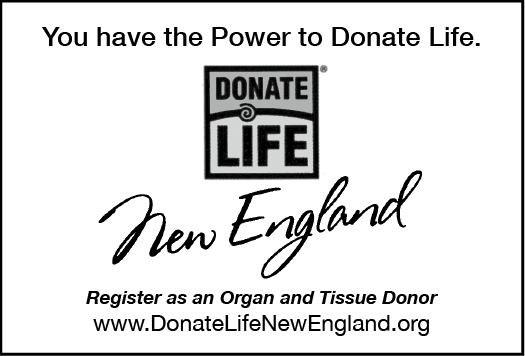
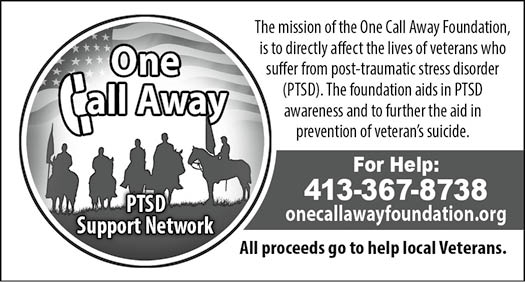
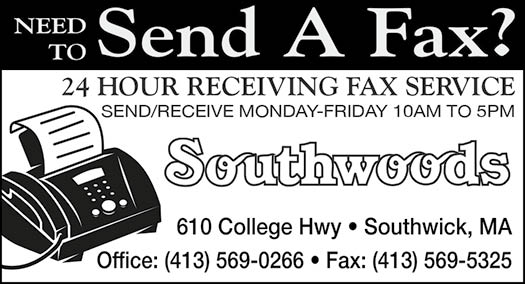

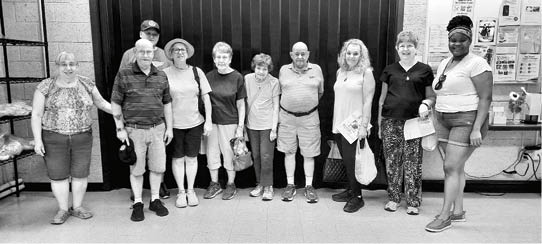

By Jennifer DiPietro
for the Southwick Agricultural Commission
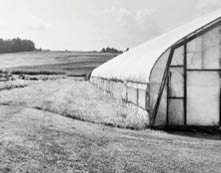


Radiant
Sunflowers
By Michael Dubilo






To include your event, please send information by the 1st of the month. We will print as many listings as space allows. Our usual publication date is around the 10th of the month. Email to: magazine@southwoods.info.
Columbia Greenway Rail Trail
Glow Walk
November 1st: Westfield, MA — Grab a flashlight and walk along the Columbia Greenway Rail Trail as the Westfield High Band plays. The walk will feature the waxing gibbous phase of the moon appearing over the tobacco field near the dry bridge. Glow sticks will be provided. Meet at the Stop & Shop trail entrance at 5:30pm. All are welcome at this free event but please bring a canned good for the food pantry. No rain date.
Southwick Lions Club
Chicken and Pasta Dinner
October 18th Westfield, MA — The Southwick Lions Club will be hosting a chicken and pasta dinner on Saturday October 18th at the Southwick American Legion Post 338 Hall, 46 Powder Mill Road from 5-7pm. Cocktail Hour is from 5-6pm and dinner will be served at 6pm. Dinner will include Chicken Pasta with herb butter sauce, salad, bread, and dessert. Tickets are $15 each and can be purchased at the door or from a lions club member ahead of time. Proceeds will be returned back to the community in-kind through programs in need and scholarships.
Southwick Congregational Church
Call for Crafters
Southwick, MA — The Southwick Congregational Church in Southwick, MA will be having their annual Holly Bazaar on Saturday, December 6, 2025 from 9:00 AM – 3:00 PM. This is a call for CRAFTERS who are interested in being a part of this community event. To rent table space and receive a registration form, please call the church office at 413-569-6362, or see the website at SouthwickUCC.org.
Western Hampden County Public Health District
Public Health Services
The Western Hampden County Public Health District serves residents of Southwick, Russell, Tolland, Blandford, Granville, and Montgomery. As part of a shared service agreement, the grants’ purpose is to unite municipalities to increase cross-jurisdictional sharing of public health services to strengthen service delivery. As well as meet Massachusetts Public Health Performance Standard by pooling resources, sharing staff, and creating partnerships between the smaller local health departments. Shared staff include public health nurses, and a shared service coordinator who promote public health practices including public health education presentations, infectious disease case investigations, CPR/Stop-the-Bleed trainings, and blood pressure clinics. More information can be found at the district’s new website at www.whcphd.com “
St. Joseph’s Church
Polish Fare Dinner
Sun, Oct 19th Westfield, MA — St. Joseph’s National Catholic Church at 73 Main Street in Westfield is hosting a Community Dinner featuring authentic Polish Fare on Sunday, October 19th at 12 noon. This community feast will feature delicious Cheese Pierogi, Kielbasa, Galumpki, Lazy Cabbage Pierogi, Pickled Beets, Rye Bread, and Apple Crisp with Vanilla Ice Cream for Dessert. Coffee, Apple Cider, and Bottled Water will also be available. Tickets are $18 for adults and $10 for children under 12. For tickets, phone or text Cliff at (413) 977-2007. Deadline for purchasing all tickets is October 16th. A limited number of Meals-To-Go will be available at 12:30pm (when buying your tickets, please indicate if you are dining with us or planning take-out). All are welcome. Please join us for an authentic, traditional Polish dinner!
Copper Hill United Methodist Church
Holiday Bazaar
November 22nd: Granby, CT — Join us for our annual Holiday Bazaar on Friday November 21, 2025 from 1pm - 4pm and Saturday November 22, 2025 from 9am - 3pm at Copper Hill United Methodist Church 27 Copper Hill Road East Granby, CT. We will have loads of hand- crafted items, a “White Elephant “ table, as well as great baked goods to choose from! A soup luncheon will be offered Saturday from 11 - 2 pm
Southwick Civic Fund
Annual Farm Parade
November 1st: Southwick, MA — Join us for the annual farm day parade Saturday November 1st at 2pm. The parade will kick off from Interstate Building Supply and end at Town Hall. This year we will have FREE Hotdogs courtesy of the Southwick Police and Fireman’s Association. Served on the town green/war memorial. Gather your family, friends, and the small town pride. If you would like participate you can sign up on southwickcivicfund.org.
YMCA of Greater Westfield
Cycle for a Cause
November 1st: Southwick, MA — Come on by to Cycle for a Cause from 8am to 12pm, Saturday November 1st! Cycle for a cause is a four hour cycling event that helps to raise funds for the Y’s Annual Campaign. The Y provides all individuals and families and families an opportunity to participate in quality programs regardless of their ability to pay. To find out more info please visit https://www.westfieldymca.org/support-y/cycle-cause
Southwick Historical Society
A Walk with Southwick Spirits
October 25 Southwick, MA — For the thirteenth year in a row, the Southwick Historical Society, Inc. is presenting “A Walk With Southwick Spirits” at the Old Cemetery in Southwick on October 25th from 1 to 4pm with a rain date of Sunday October 26. Location is 322 college highway. Enter through the main gate of the new cemetery and proceed to the left rear corner for parking. Reservations are strongly suggested to avoid delays and assure a spot. You may call (413) 210-5870 to reserve. Suggested donation is $5.00. Wear comfortable shoes as the ground is uneven. Also, have a jacket, etc as weather dictates.
Wyben Union Church
Christmas Craft Fair
December 6th: Westfield, MA — Mark your calendars the beloved Wyben Christmas Craft Fair is making its festive return on Saturday, December 6th, and you’re invited to celebrate the season in style! From 9:00 a.m. to 3:00 p.m., Wyben Union Church (678 Montgomery Road, Westfield) will be transformed into a holiday marketplace brimming with handcrafted treasures and seasonal treats. It’s the perfect spot to find one-of-a-kind gifts made with heart. The local 4-H Club will also be on hand, offering their ever-popular fresh evergreen wreaths.
Come hungry! The kitchen will be serving up its famous corn chowder luncheon, and a mouthwatering array of home-baked goodies are for sale to satisfy every sweet tooth. Even better? Every bite and every raffle ticket helps make a difference. All proceeds from the kitchen, baked goods, popcorn, raffle sales, and vendor space rentals will go directly to benefit a local charitable organization. So bring your friends, your appetite, and your holiday spirit. We can’t wait to welcome you back to Wyben for a day of shopping, snacking, and giving back!



COUNTRY PEDDLER
CLASSIFIEDS
GOODS & SERVICES
DELREO HOME IMPROVEMENT for all your exterior home improvement needs, ROOFING, SIDING, WINDOWS, DOORS, DECKS & GUTTERS extensive references, fully licensed & insured in MA & CT. Call Gary Delcamp 413-569-3733
RECORDS WANTED BY COLLECTOR - Rock & Roll, Country, Jazz of the 50’s and 60’s All speeds. Sorry - no classical, showtunes, polkas or pop. Fair prices paid. No quantity too small or too large. Gerry 860-402-6834 or G.Crane@cox.net
GOODS & SERVICES





Lakeside Property management - For all your landscaping needs. Mowing, new lawn installs, sod, mulch/stone installation, bush trimming, retaining walls, snow plowing/removal, etc. Serving Southwick, Suffield, Granby, Agawam, Westfield, Simsbury. Residential and commercial. Call Joe 413-885-8376. Give us a call and let us get that property looking the way you want it! Now accepting major credit cards.


The granby motel- 551 Salmon Brook Street Granby, CT 06035. Room for rent, weekly, daily, & monthly. Wifi available. Stove, Refrigerator, Kitchen. LONG TERM RENTAL AVAILABLE AT AFFORDABLE PRICE. Ask for Mike Shaw. 860-653-2553
St. Jude’s Novena - May the sacred heart of Jesus be adored, glorified, loved and preserved throughout the world now, and forever. Sacred Heart of Jesus pray for us. St. Jude, Worker of Miracles, pray for us. St. Jude, Helper of the Hopeless, pray for us. Say this prayer 9 times a day. By the 8th day your prayer will be answered. It has never been known to fail. Publication must be promised. Thank you St. Jude. ..- MM
St. Jude’s Novena - May the sacred heart of Jesus be adored, glorified, loved and preserved throughout the world now, and forever. Sacred Heart of Jesus pray for us. St. Jude, Worker of Miracles, pray for us. St. Jude, Helper of the Hopeless, pray for us. Say this prayer 9 times a day. By the 8th day your prayer will be answered. It has never been known to fail. Publication must be promised. Thank you St. Jude. ..- DG